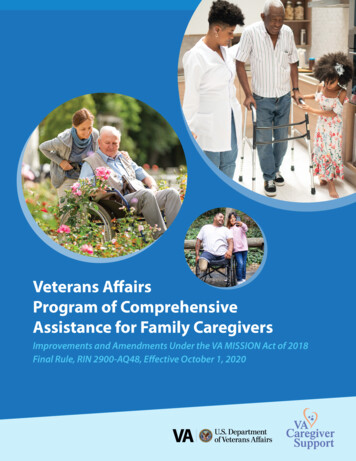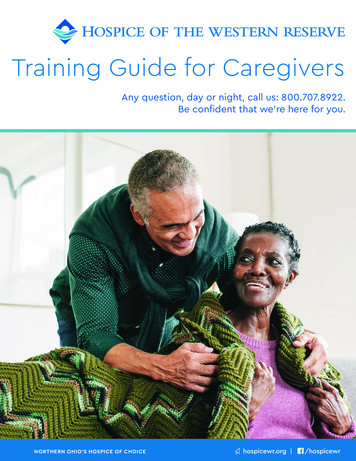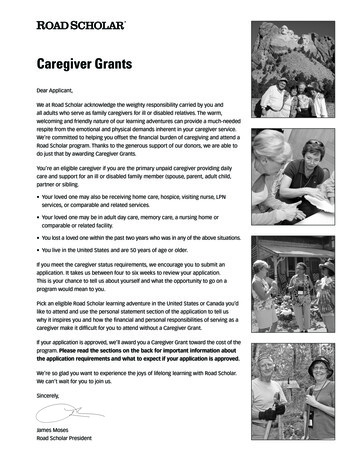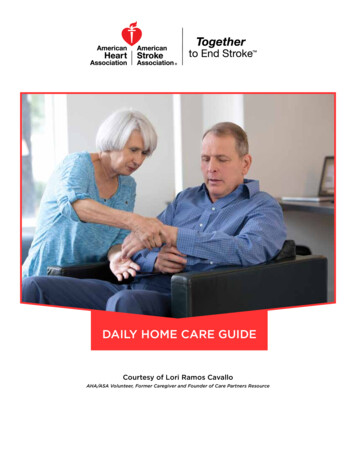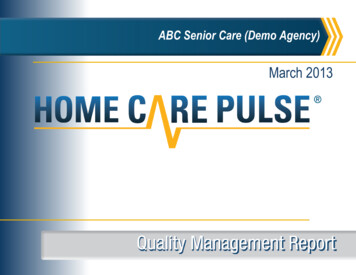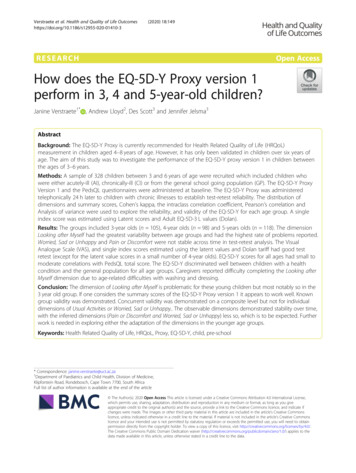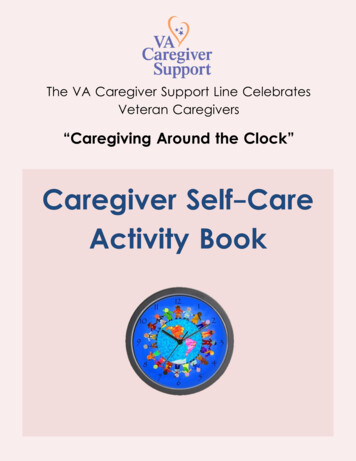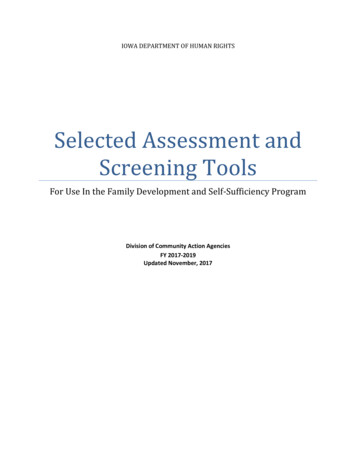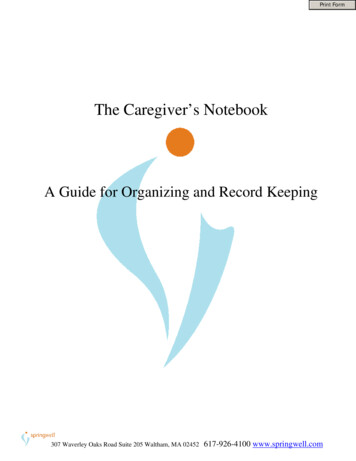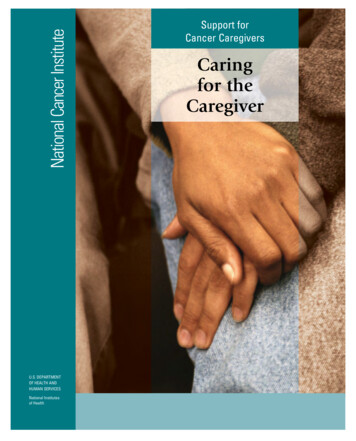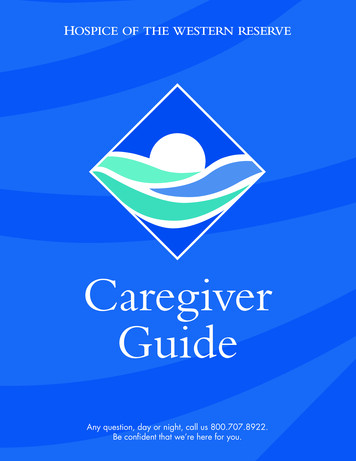
Transcription
hospice of the western reserve2CaregiverGuideAny question, day or night, call us 800.707.8922.Be confident that we’re here for you.Be confident that we’re here for you.
Table of ContentsIntroduction1Other Programs and Information7Patient Care8Cardiopulmonary and Heart Failure21Dementia23Home Safety29Caregiver Needs31Reference36Personal Planning41Memorial Planning44Burial Benefits, Probate36Quick Reference36Any question, day or night, call us 800.707.8922.
On behalf of the entire staff of Hospice of the Western Reserve, I wouldlike to thank you for choosing us as a caregiving partner. We are honoredto be entrusted by you, and assure you that we are committed to providingcompassionate, exceptional care, focusing on the priorities and values of youand the person receiving care.William E. Finn, CEOA Letter from the CEOWelcomeOur teams will work to assist you in reaching your goals, ensuring that yourwishes are realized, and to provide physical, emotional, and spiritual care ofthe very highest quality. Hospice of the Western Reserve has served patientsin Northern Ohio for over 30 years. We are Ohio’s largest independent, nonprofit, community-based hospice program.This guide provides you with the information and resources needed tosupplement the services that we provide. It is not meant to be a substitute forcare, as we are available 24 hours a day to answer your questions, alleviate yourconcerns, and ease your burdens.We consider it a privilege to play a significant role in your life during thistime. You and your loved ones can count on Hospice of the Western Reserve’ssupport and compassionate expertise every step of the way.Sincerely,William E. Finn, CEOHospice of the Western Reserve“You matter because you are you. You matter to the lastmoment of your life, and we will do all we can, not onlyto help you die peacefully, but also to live until you die.”–Dame Cicely Saunders, founder of the modern hospice movementBe confident that we’re here for you.1
IntroductionOur MissionHospice of the Western Reserve provides palliative and end-of-life care,caregiver support, and bereavement services throughout Northern Ohio.In celebration of the individual worth of each life, we strive to relievesuffering, enhance comfort, promote quality of life, foster choice in end-of-lifecare, and support effective grieving.2IntroductionHospice of the Western Reserve providespeople who are dealing with a serious illnessthe unique experience to celebrate life, toenjoy the time they have, and to live outtheir lives with dignity. The focus of hospicecare is comfort for the person receiving care,and support for you—the caregiver. Our staffworks to manage pain and symptoms, provideemotional support, and explore spiritualneeds, but you and the person receiving careare in control of the care plan.How do you help someone who is dying?This question is often asked of hospiceworkers. The answer is not found in thetechniques, but in one’s own experienceof sharing the final stage of life’s journeywith those who are dying. Medications andtreatments are important, but we know thatsomething more is needed. The real work ofhospice is being physically and emotionallypresent through the trials and joys.Any question, day or night, call us 800.707.8922.The staff at Hospice of the Western Reservecreated this guide to provide you with animmediate source of information to answermany of the questions you might have asyou go through the end-of-life process.Confidence in Your CaregivingDuring this stressful time, your Hospice ofthe Western Reserve team strives to help youfeel more confident in providing care andsupport. To this end, we will provide you withmedication education, medical information,telephone guidance, and ongoing discussionsas the disease progresses.We continually assess our patients and youthe caregiver. We want to hear what youare seeing and feeling through this process.Team members will ask, “How can we helpyou feel more confident in providing care?”Whatever your questions or concerns, let usknow. We are here for you too.
Where can hospice care beprovided? In a private home Group home Nursing facility One of our Hospice Care Settings (refer topage 5) Hospital Assisted living facility Anywhere the person calls “home”Does the patient keep his/herown doctor?Yes. Hospice of the Western Reserve worksdirectly with the patient’s doctor. If youwould like to change physicians or do nothave your own, Hospice of the WesternReserve has its own practice of certified,experienced hospice physicians.What happens if the patientmoves away?A transfer to another Medicare-certifiedhospice can be arranged by your hospice team.What if the patient no longerwants or needs hospice services?We will always honor the wishes of thepatient or his/her designated representativefor treatment. If services are no longerneeded or desired, the patient will need tosign a discharge form. There are times whena patient’s condition stabilizes, and the teamwill discuss the need to be discharged. Afterthis time, the patient may join our NavigatorProgram (see Other Programs on page 7)and a team member will call periodicallyto check on the patient’s condition. If younotice changes in the patient’s physicalhealth, call us. Hospice services will always beavailable when needed.Hospice Team MembersSpecially qualified and trained team membersprovide hospice services. The personreceiving care and caregivers arevital members of this team. Togetherwe decide on an ideal plan to maintaindignity and ensure that physical, emotional,and spiritual needs are met. Comfort andconfidence are our priority.IntroductionFrequently Asked Questionsabout HospiceOther members of the Hospice team include:The Primary Physician for the personreceiving care is responsible for continuedmedical management.The Hospice Physicianacts as a resource for hospice medical care, andreviews the plan of care on a regular basis.A Hospice Nurse visits on a regular basisto perform physical assessments, provideseducation on medications, physical careneeds, and updates the doctor.Your nurse isvaluable source of knowledge.Your Social Worker helps explore careoptions, understand legal and financial issues,find emotional support and is available forcounseling. Social workers are dedicated tohelping the patient and family with the manyareas of life impacted by an illness.Nursing Assistants often have the mostfrequent interactions with patients, and canbe a great source of helpful information. Ournursing assistants are experienced in hospiceand palliative care. They care for patientsnot only in the traditional duties of bathing,dressing and personal care, but in beingpresent for emotional support.Spiritual Care Coordinators explore waysto find joy, meaning and purpose in life. Forthose who have a religious faith, this mayinclude working closely with your clergyperson and faith community. Everyone canbenefit from their listening ear, guidance andBe confident that we’re here for you.3
Introductionwillingness to explore questions, forgivenessand hope.Volunteers may: Provide a friendly visit or respite for acaregiverArt and Music Therapists provideopportunities for life review and thecreation of legacies through art and musicexperiences. They work with patients andcaregivers to relieve symptoms and expressfeelings. Offer spiritual care supportA Massage Therapist integrates massagetherapy into the plan of care as needed topromote comfort, relaxation and relief fromphysical symptoms. Provide simple legal assistancePharmacists strive to relieve pain andmanage symptoms with minimal side effectsand maximum benefit.A Dietician provides suggestions onnutrition and symptom management.4Overnight and Weekend Team Membersassure access to care 24 hours a day, 7 days aweek.Your confidence and comfort are ourpriority.A Bereavement Coordinator, trained insupporting those who are grieving, offerssupportive services to family members andsignificant others during the 13 monthsfollowing a death.Coordinators of Volunteers help identifyareas in your life where a volunteer may offerassistance. They discuss the role of a volunteerwith the patient and caregiver before asking avolunteer to join the team.Volunteers are valuable members of yourteam and may be a great source of support.Volunteers receive extensive education andare dedicated to maintaining the privacy anddignity of the person receiving care. Theyshare their unique skills and talents in manyways.Any question, day or night, call us 800.707.8922. P reserve life experiences through audio orvideo recording Bring a pet to visit A ssist with occasional housekeeping andmeal preparation P rovide support to Veterans through ourPeaceful & Proud Program (see OtherPrograms on page 7) A ssist patients through the health caresystem with the Navigator Program (seeOther Programs on page 7) P rovide support and presence in the timesurrounding death H elp fill a special request to bringfulfillment and comfort Plus many more optionsOn-Call ServiceOften, questions, concerns, and problemsoccur during the night or on weekends. Weencourage caregivers to use our on-call servicewhen these needs arise. We want you tofeel confident calling for support. A nurseis always available through our on-call service.The on-call number is on the card that lookslike the one in the back of the guide. We haveplaced the card near the telephone or othereasily located area in the home.Our answering service will promptly answeryour call requesting the patient’s name andthe reason for your call. The on-call nurse willbe notified and will return your call within15 to 20 minutes. Please do not use yourtelephone while awaiting this returncall. If your call is not returned in 15 to 20minutes, please call again.
IntroductionIf there is a change in the patient’s conditionor a medical emergency, call Hospice ofthe Western Reserve first. We request thatyou do not call 911.Hospice Services in Long-TermCare SettingsPeople living in long-term care settings,including nursing homes, assisted livingfacilities or group homes, may receivehospice care. A team of specialized hospiceworkers, who are familiar with the staff atthese facilities, provide the same supportand care for a resident as they would for aperson living in a private home. Hospice ofthe Western Reserve works collaborativelywith many long-term care settings in theNortheast Ohio area, enhancing the careprovided by nursing facility staff.If the patient is eligible for a hospice benefitthrough private insurance, then supplies,equipment, and medications needed as aresult of the serious illness will be covered.The charge for room and board is notcovered under the Medicare Hospice Benefit.If the patient is living at home, but expectsto enter a long-term care facility, the hospicesocial worker will help locate a facility thatworks in collaboration with Hospice of theWestern Reserve.Our Hospice Care SettingsOther than Your HomeHospice of the Western Reserve offerschoices in our home-like Hospice CareSettings. Each setting has its own array ofservices, which we tailor to meet the needsof our patients and their caregivers.Yourparticipation in care is welcome in makingthe best choice to meet your needs.General Inpatient Care/SymptomManagementIf a patient has pain, nausea, shortness ofbreath or other symptoms that cannotbe managed in the current residence, thehospice team may suggest an admissionunder the General Inpatient level of care.Usually the patient will be admitted to oneof our Hospice Care Settings for symptommanagement. However, if the patient orthe patient’s physician prefers, an admissionmay be arranged at a local hospital. Manylocal hospitals contract with Hospice of theWestern Reserve to provide this service.Residential CarePatients at a Hospice Care Setting for GeneralInpatient care who need to stay once painand symptoms are managed, may be eligibleto transition to the Hospice Residential levelof care at one of our Hospice Care Settings,based upon bed availability. Daily room andboard charges will be billed automatically.Respite CareThere are times when caregivers may needa short interval of rest or relief from theircaregiving duties. A patient may be admittedto one of our Hospice Care Settings forRespite Care, based upon bed availability,or to a facility with which Hospice of theWestern Reserve has a contract. A Medicareor Medicaid patient may be admitted for upto five days for Respite Care with no roomand board charges.Be confident that we’re here for you.5
IntroductionPreparing for Transfer to one ofour Hospice Care SettingsPlease refer to the Patient and FamilyAdmission Guide to the Hospice CareSettings for further details including billinginformation, room and board charges (whereapplicable), transportation, and what to bring.Extended Care6If a patient has pain, nausea, shortness ofbreath, or other symptoms but desires toremain in the place of residence, the hospiceteam may suggest Extended Care, alsoknown as Continuous Care. During thistime, hospice services will be provided inblocks of time of two to four hours or more.Occasionally, care may be needed aroundthe-clock for very severe symptoms, but thisis not the usual case. The patient’s regularhospice team will continue to oversee thecare; however, other hospice team membersmay come and go to provide care as well.This type of care is meant only to beshort term. The patient’s condition will bere-evaluated frequently while receivingExtended Care.Once symptoms are controlled, the patient willreturn to routine hospice care. Extended Careis not meant to take the place of the patient’sregular caregivers in providing for general dailycare and safety of the patient, rather it is gearedtoward managing active symptoms.What can you expect of us whilereceiving Extended Care? W e will reposition bedbound patientsand bathe/change incontinent patientsfrequently for comfort and to prevent skinbreakdown. O ur staff will bring their own food andbeverages and will not smoke while inyour home. Staff members are alloweda 30-minute meal break and up to two,10-minute breaks during an 8–12 hourshift.Any question, day or night, call us 800.707.8922. O ur staff will remain awake and alert atall times, will conduct themselves as guestsin your home, and will be courteous andrespectful at all times. I n addition to regular visits by your primaryteam, you may encounter different staffmembers while you are receiving thisservice, including volunteers. O ur staff will document on a laptopcomputer while in your home to recordcare given and keep other staff membersupdated on the patient’s response to the planof care.What can you do to maximize thebenefits of Extended Care? S tay involved in the patient’s care. Please beavailable for visits from your primary teamand assist in planning for the patient’s carewhen the current symptoms are managed.Ask questions freely and as often as needed. Y ou are always welcome to make decisionsthat you feel are in the best interest of thepatient, such as not turning in bed, refusingmedications, etc. Please discuss thesedecisions with your primary team. I f at any time you are not satisfied with aparticular staff member in your home, pleasecall your primary team or our On-Callservice to request a replacement.
Palliative CarePalliative care extends the principles ofhospice care to a broader population ofpatients who are not ready for hospice ordo not choose it but could benefit fromdisease management earlier in their illness.Considering the physical and emotional tollsymptoms can take, palliative care aims toease pain, insomnia and shortness of breath, aswell as anxiety, depression and other intenseemotions.Navigator ProgramWhile under the compassionate care ofhospice, some patients improve to the pointwhere they no longer fit into hospice orpalliative care guidelines. We stay connectedwith them through our Navigator Program.Social workers, advance care nurses andeducated volunteers provide assistance withcommunity resources, caregiver support, painand symptom management and supportivesocial visits.Peaceful & Proud: PersonalizedCare for VeteransThrough the Peaceful & Proud program,Hospice of the Western Reserve paid andunpaid staff receive training in post-traumaticstress disorder and other emotional issues forVeterans, such as remorse or regret, anxiety,and substance abuse.Veterans are assistedwith ethical wills, storytelling, expressivetherapies using music and art,Veteran-toVeteran-volunteer pairing, spiritual careand counseling, resources and benefits forVeterans and dependents. We recognizeVeterans for their military service with ourHonored Veteran pin.Research OpportunitiesThe Hospice Institute supports researchprojects and studies that will further thescience of hospice and palliative care. Formore information or to participate, pleasecontact us at 216.383.3740.Patient Travel InformationHospice of the Western Reserve understandsthat there are occasions when the personreceiving care will need to travel to adestination that is out of our service area.Many of the hospices in the United States arewilling to collaborate with Hospice of theWestern Reserve. Please notify your hospiceteam as soon as possible, preferably at leastfive business days prior to traveling,so we may contact a hospice and makearrangements for your access to hospice care.Other Programs and InformationOther Programs andInformationOur policy supports travel outside of ourservice area for 14 consecutive days. If stayinglonger than 14 days, please inform thehospice team and alternate arrangements canbe made for these situations. The team willprovide appropriate forms to be completed.If the patient’s status changes during traveland requires inpatient care, we will assistwith the transfer of hospice care to thehospice provider in the area. If you have anyquestions regarding traveling, please consultyour hospice team.Be confident that we’re here for you.7
Patient CarePatient CareWhen to Call HospiceDignity and Comfort No relief in painThe members of your hospice team striveto preserve dignity and comfort. What isdignity? Dignity means many things to manydifferent people. For Hospice of the WesternReserve, dignity is life history, family, friends,work, hobbies, feelings, hopes, dreams andlife lessons—all the things that are mostimportant to our patients; the things thatmake him/her unique and special. S ide effects, which may include constipation,drowsiness and/or nauseaTell your hospice team what they need toknow about the person receiving care notingpain and other symptoms (such as breathingtrouble, nausea, weakness, constipation). Inaddition, keep your team informed of youremotions and feelings.Your hospice team ishere for you too.Pain Education8Managing pain is most important to us. Painis whatever the person receiving care says itis, existing whenever he/she says it does.Please be confident that: Reports of pain will be believed W e will educate you about pain and painrelief measures Your team responds quickly to reports of painHelpful Hints A sk the team about what to expectregarding pain and pain management W ork with your team to develop a painmanagement plan Increase in pain, new pain or discomfort Questions regarding pain management A rapid decline or change in patient Q uestions regarding dosage and/ormedication changesEffective Pain ManagementPain can be physical, emotional or spiritual.Pain can be caused by many factors such asswelling, nerve damage, or progression of adisease.Your hospice team will continuallyevaluate pain symptoms for each patient.What Can Be DoneHelp the person receiving care try to describethe pain. Use words like: Sharp Constant Shooting Squeezing Dull Aching BurningTry to rate the pain “0” (zero) is no pain “10” is the worst painTell your team what makes the pain betteror worse, and how well pain medications areworking. We encourage you to write downany and all questions you have. Share themwith your hospice team, or call us anytime.Helpful Hints Report pain when it first begins Relaxation techniques R eport any problems that you think thepain medications may be causing, as theremay be other options D istractions (watch a movie, visit withfriends, play a game, listen to music) T ell your team if you are having anydifficulty getting medications or haveconcerns about them Hot or cold packs Report feelings of anxietyAny question, day or night, call us 800.707.8922. Soak in a tub, if able Guided imagery Light massage or touch
Moaning Frowning Restlessness Tenseness TearsMedicationsMedications come in different formsincluding: pills, liquids, inhalants, patches,suppositories and ointments. Medicationsmay be changed into different formsdepending on the patients needs, such asdifficulty swallowing. Let your hospice teamknow if you have less than a two-day supply.DO Read the medication label first. A dminister all medicine exactly as it iswritten on the prescription or as orderedby the physician, for example “with food.” A dminister routine medication on aregular schedule, timing is very important. U se break-through or in-between medicineas instructed by the hospice nurse andphysician to prevent pain from escalating. T ell your hospice team before stopping orchanging medications. K eep a written schedule and record ofwhen and how often medication is taken. A void alcoholic beverages while takingmedicine. T ell the hospice nurse about any overthe counter drugs, vitamins, mineralsupplements or herbal remedies that arecurrently being taken.Helpful Hints T o ease swallowing pills, moisten mouthwith water or add pills to applesauce orpudding. Some pills may be cut in half. I f giving a medication rectally, it is bestto administer after a bowel movement ifapplicable. Using a glove, lubricate onefinger and insert the medication at least2/3 of the finger’s length. W hen using liquid medicine, slightly tilthead upright and slowly pour the medicinedown the side of the mouth. W hen administering medication under thetongue or between the cheek and gum,moisten the area with two to five drops ofwater and then place the pills in that areaas directed by the hospice nurse.Medication Record and SchedulePlace medication record and schedule in aplace where hospice team members can find it,so they can make sure the patient is receivingthe correct medication(s) and doses. Keep theDNR card with the medication schedule.Medication DisposalFirst, remove any personal information fromthe medicine label (peel label off, crossingoff with a permanent black marker). Disposalcan occur in the original container or placeall medications in a sealable bag, empty can,or empty plastic container depending on theamount of medication. Add water to dissolve pill or tablet dosageforms. Allow some time for the dissolvingprocess to begin. Suppository form – cut up suppositories. K eep all medicine out of reach ofchildren and pets. O intments or creams – eject remainderinto the container.DO NOT P atches – put on gloves and cut up andplace in opaque bag. Share medications with anyone else C rush pills unless directed or instructed byyour hospice nurse Take more than the amount that is orderedPatient CareLook for and communicate to your team signsof discomfort for patients who cannot speak. I njectables – withdraw remainder andinject into the container. Syringes – eject remainder into the container Liquid – pour into the containerBe confident that we’re here for you.9
Patient Care10Add used coffee grounds, kitty litter, orflour to the container to make the mixtureundesirable and unusable. Place in a trashreceptacle, preferably inside a non-clear bag,if able, to further discourage identification.Do not flush medications down a toiletunless specifically instructed to do so on thedrug label or by a hospice team member.If you have questions or need instruction,please call your hospice team.Controlled SubstancesControlled substances are specific medicationsdetermined by legal authorities to havea greater need for careful and preciseaccountability. Examples of controlledsubstances include many pain medicationslike morphine and some anxiety medications like Ativan (lorazepam). Theuse of controlled substances at Hospiceof the Western Reserve is based on apatient specific pharmaceutical plan ofcare, involving critical assessment, carefulmonitoring, and physician authorization.Side Effects of Pain MedicationAll medicines can have some side effects, butnot all people experience them. People reactin different ways.Your doctor or hospicenurse can help work through any side effects.SleepinessPatients tend to experience fatigue whenfirst starting or recently increasing a painmedicine. Often after two to three days offollowing a pain treatment plan, the feelingwill pass. The body adjusts to the change.Remember, pain is tiring and with relief ofpain, the patient will sleep.Constipation (having no bowel movement orsmall, hard stools)Certain medication, especially painmedication, will cause constipation. If able,drink more water and fruit juices. The nursewill talk with the patient about a laxative.Taking laxatives and/or a stool softenerAny question, day or night, call us 800.707.8922.routinely each day will prevent constipation.Call the hospice nurse if there is no bowelmovement in two days, patient experiencesabdominal pain or cramping, nausea and/orvomiting, or blood in stools.Nausea and VomitingWhen starting a new pain medicine, or asthe result of infection, anxiety or diseasechange, the patient may experience nauseaand vomiting. Call the hospice nurse whowill arrange for some medicine to help. Donot stop taking the pain medicine withoutspeaking to the hospice nurse first. Avoid dairyproducts, heavy meals, fatty foods, strong odors,excessive activity and lying down after eating.Helpful Hints R educe anxiety with meditation, quiet,music or slow breathing techniques A dminister anti-nausea medication asordered Keep patient still and rested Offer small sips of ginger-ale or peppermint tea Rinse mouth thoroughly after vomiting T ake ice chips, popsicles or flavored ice forhydration C ontinue taking clear liquids for 24 hours(ginger ale, Jell-o, Gatorade) after vomitting A dd bland foods (crackers, dry toast, drycereal) after 24 hours following liquid dietDO NOT Eat or drink 1–2 hours after vomiting Be around strong odors Eat any spicy or fatty foodsWhen to Call Hospice Vomiting recurs after starting to drink Vomit is bright red or dark brown Continued constipation Unable to swallow Y ou have concerns about medicating theperson receiving care
Diarrhea is characterized by loose or waterystools. It may be accompanied by painand stomach cramping. Diarrhea that doesnot stop can cause dehydration, weakness,electrolyte imbalances, and increased stomachpain. Try a diet of clear liquids (water, broth,ginger ale), and keep rectal area clean anddry. Do not give the patient anti-diarrheamedication unless instructed by the hospicenurse. If diarrhea has stopped for 8 to 12hours, try dry toast, dry crackers, bananas,rice and clear liquids. Call the hospice teamif there is light-headedness, fever, inability tourinate or continued diarrhea. I f the patient is pulling on the catheter, puton an adult diaper to hold it more securelyin place and keep it from moving W hen turning from side to side, move thedrainage bag from side to side I rrigate the catheter if the nurse hasinstructedWhen to Call Hospice Catheter is not draining Urine has an odor or change in color Patient spikes a feverNutritionHelpful HintsIt is normal for seriously ill patients tohave changes in the way they eat anddrink. Frequent oral care, small sips of fluid,ointment to the lips and light massage withlotion are all ways to support the patient atthis stage. Try offering food often duringthe day; three to six light meals or smallerportions are usually better tolerated. Offerfluids between meals, instead of with meals,to keep from feeling full, and arrange mealtimes when he/she is less tired. Do notforce the patient to eat. W ash your hands before and afterhandling the catheterHelpful HintsCaring for a CatheterA catheter is a tube inserted into the bladderto help drain urine. It has a small balloon thatis blown-up to keep the tube from fallingback out. A catheter may be needed due toincreased weakness, loss of bladder control,etc. If a catheter becomes needed, the hospicenurse will place it and show the caregiverhow to care for it. C heck the tubing periodically to see ifurine is draining Avoid eating when nauseated or in pain B e sure that the tubing is not kinked orbent S et a nice table, add candles or flowersplay music, garnish food to make it morepleasing to the eye C hange the drainage bag weekly, as thenurse demonstrated E mpty the drainage bag 1–2 times per day,leg bags every 3-4 hours K eep the drainage bag below the level ofthe bladder at all times D o not pull or tug on the catheter ortubing C leanse the tubing with soap and waterdaily and when the tubing gets soiled Be sure to begin where the tubingenters the body and work awayPatient CareDiarrhea11 Share meal times with others U se a warm/cool moist cloth prior toeating to freshen face and hands H ave options or choices available ahead oftime V ary food preparation techniques: grill, fry,broil, roast Have good tasting snacks readily available Try ice chips or Popsicles Use herbs, spices, and other seasoningsBe confident that we’re here for you.
Patient CareChanges in Taste and SmellDue to the progression of an illness, ormedications and treatments, foods may tasteand smell differently, or have little or no tasteat all. This can reduce appetite. Begin eachmeal or snack with a clean mouth. Brush teethand use a mouth rinse. Try brushing to
Personal Planning 41 Memorial Planning 44 Burial Benefits, Probate 36 Quick Reference 36. Be confident that we’re here for you. . This guide provides you with the information and resources needed to . their
